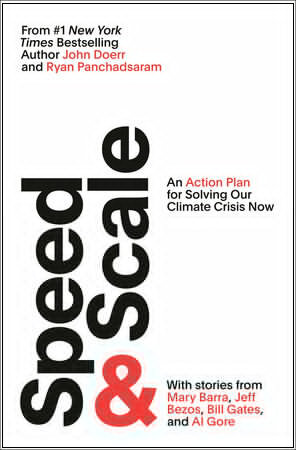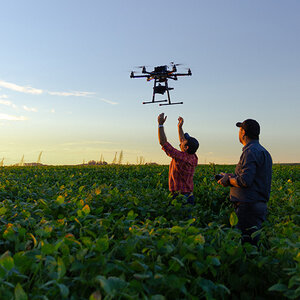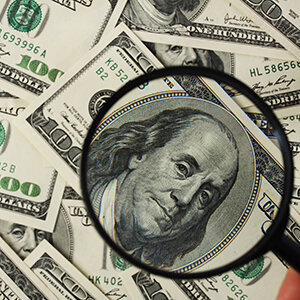Speed & Scale: An Action Plan for Solving Our Climate Crisis Now
In the movie Crazy People, Dudley Moore’s advertising “Mad Man,” stuck in a traffic jam on a bridge and late for a meeting, desperately shouts at the other drivers: “If you’d just go, there wouldn’t be any traffic!” To no one’s surprise the cars do not move. The problem, of course, is that while the drivers all have the same objective, they lack the means to effect change. Without a plan, without measurable goals, without even understanding the problem, the cars will never move. The solution is so far ahead, so out of sight, and of such a large scale that all Moore’s character can do is scream. Today’s climate crisis is like that traffic jam, except that we do not have the luxury of shouting into the wind. And that makes John Doerr’s Speed & Scale: An Action Plan for Solving Our Climate Crisis Now, an essential read.
An electrical engineer by training, Doerr made his bones as a top salesman at chip giant Intel in the 1970s before joining the venture capital firm Kleiner Perkins, making early bets on Amazon, Intuit, and Google — and making a fortune. (More than two decades after his initial $12 million investment, the billionaire remains a board member of Google’s parent company Alphabet). His engineer’s mind has also made him a keen observer of the big picture, able to see how smaller processes combine to help or hinder progress toward larger goals. And his salesman’s aptitude for understanding his audience has made him a vital explainer of complexity. In his widely read 2018 book, Measuring What Matters, and its companion website, Doerr evangelized the OKR (objectives and key results) goal-setting framework that he learned from Intel’s Andy Grove, and famously leveraged in his early work with Google. With case studies illustrating the effectiveness of the OKR at the Bill and Melinda Gates Foundation and U2 front man Bono’s ONE Campaign, among others, Doerr showed how understanding larger goals and conspicuously and intentionally breaking those goals down into achievable tasks can make the impossible possible. In Speed & Scale, Doerr takes OKRs to the front lines of the fight to mitigate human-made climate change.
In the OKR framework, objectives are your big principal goals (say, achieving a carbon-neutral economy by 2050), where key results are the meaningful, measurable, achievable targets (say, decarbonizing energy or electrifying transportation) that allow you to arrive at your ultimate goal. The idea that “to execute a big plan, you need clear and measurable goals” is not a revelation. What is striking about the OKR approach is the purposeful pursuit of continuous performance measurement, stripping away our tendency to think linearly; that one goal must be achieved before moving to the next (sometimes described disapprovingly as “the waterfall”). With OKRs the inherent practice is to move toward larger goals from many directions, evaluating success (or failure), and shifting strategies in an ongoing, intentional process.
Today's climate crisis is like a traffic jam, except that we do not have the luxury of shouting into the wind.
Doerr makes clear that the problem of climate change “is so complex that it tests our ability to comprehend it, much less solve it.” Had we acted decades ago (the movie Soylent Green popularized the Greenhouse Effect in 1973), he argues we might have been able to make incremental reductions in greenhouse gases (say, 10 percent a decade), but we have squandered that leeway: “[W]e’re not cutting our emissions fast enough to outrun the damage on our doorstep.” But Doerr refuses to be stuck in traffic or to allow that we have no choice but to brace for a “doomsday scenario.” Tracing this conviction to a viewing of Al Gore’s 2006 documentary film, An Inconvenient Truth — and his teenaged daughter’s admonition that “[y]ou better fix it” — Doerr started investing in “clean tech” years before it was profitable. With Speed & Scale Doerr now provides a meticulous analysis of both problem and solution. And, forever the salesman, Doerr makes what might be a dry four hundred-page PowerPoint presentation into a lively and approachable narrative full of stunning insights and ah-ha moments: doing the math on how much methane is produced to make a pound of mozzarella; illustrating how the size of wind turbines and their megawatt output is exploding exponentially; exploring Mary Barra’s plan to make GM’s cars and trucks all electric by 2035.
Following a year of pandemic and extreme weather (Doerr describes writing this book while seeing the orange glow of wildfires from the window of his Woodside, California, home office) capped by November’s United Nations Climate Change Conference (COP26) in Glasgow, Scotland, that produced both major philanthropic initiatives and breakthrough commitments to reduce methane emissions, Speed & Scale’s publication is well timed. For anyone (governments, companies, individuals) looking for a plan of action, Doerr’s OKRs on climate change present a real and sober path away from the crisis. Monumentally difficult as the task ahead may be, Doerr breaks down these impossibly large challenges, dividing what we need to do from how we will get there — and he keeps breaking it down until we arrive at detailed achievable results. This book, read for review as an e-book, includes a calorie count-like “negative” carbon footprint, something Doerr calls for across all products, goods, and services. And not for its own sake, but because it allows us on a macro scale to understand the inputs that make greenhouse gas reduction so complex. And while this is one very small example, it is all the same measurable and achievable.
Earlier this year, in How to Avoid a Climate Disaster, Bill Gates also raised the alarm, offering his own prescriptions for preventing an environmental cataclysm. But where Gates and Doerr (who has joined the Gates-led Giving Pledge and Breakthrough Energy Coalition) are surely in agreement on the objectives, that is, "what to do," Gates’ narrative is focused on the big goals, highlighting the green shoots of success, weaving a dire but hopeful narrative. While both authors call for accelerating efforts to decarbonize the power grid, both in terms of volume and clean sources of energy, Doerr squarely places that pivot within the frame of his OKRs, providing a detailed breakdown of “how to do it,” showing a clear and measurable path to reducing annual global electricity and heating emissions from today’s twenty-four billion tons of carbon to three billion by 2050. With a level of granularity that demonstrates an acute understanding of the big picture, Doerr doesn’t simply hope for solar and wind power to keep getting cheaper; he makes it a “key result” to eliminate the “green premium” from renewable energy globally — and do it by 2025. Where Gates implicitly looks to the horizon for innovations yet to come (e.g., carbon capture for cement), Doerr makes innovation an explicit, intentional element of his framework. So, too, Doerr centers movement culture (embracing Greta Thunberg’s rage) and the collaborative power of people and communities to force policy changes and accelerate transformation and innovation on a global scale. And Doerr equally understands that his ideas and plan of action need to meet its audience where they are, that is, online.
Doerr describes his blueprint as “a starting point, no more no less,” but it is abundantly clear that our global community is past waiting for an easier game plan. As Doerr puts it: “If this book scares you into action...then I’ve done my job. But for our fear to work for us, it needs to galvanize, not paralyze.” Here is a real plan for measurable, achievable results that can get us out of our climate traffic jam and across the bridge from where we were to where we need to go.
Daniel X Matz is foundation web development manager at Candid.









